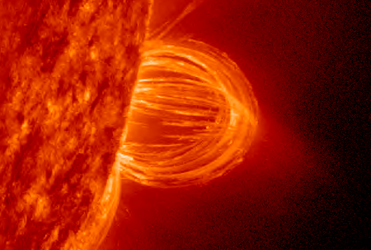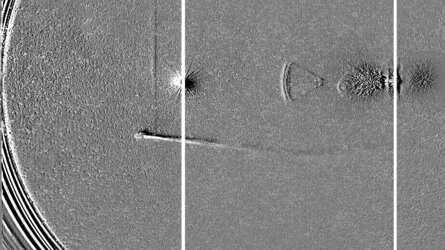

New view of 2012 solar activity gif
This impressive burst of energetic stellar activity was captured on 26 January 2012 by the LASCO cameras C2 and C3 onboard the ESA/NASA Solar and Heliospheric Observatory (SOHO).
First, a huge Coronal Mass Ejection (CME) bursts from the Sun, flinging vast masses of stellar material approximately 1200 km per second across the Solar System. It is followed by a couple of smaller and slower CMEs estimated to be travelling at 200-400 km per second.
A final CME blasts out at the end of the video, but this time it is directed at Earth. Such events are called “Halo” Coronal Mass Ejections because unlike those that are seen side-on, flung from the Sun and appearing to travel to the left or right, Earth-directed CME’s look like a ring of material that gets bigger and bigger. Once it strikes, fragments of a second later, a radiation storm disrupts instruments onboard spacecraft in the way, seen here as the chaotic ‘sparkling’ disturbances that beset the image.
“This final CME carried an estimated 37 quadrillion grams of material a whopping 2500 km per second,” explains Karl Battams, Dr of Computational Science at the US Naval Research Laboratory.
“That’s equivalent to throwing almost 0.5% of all the organic material on Earth at 1% of the speed of light!”
Although the original footage comes from 2012, this recent video uses nifty algorithms to “blend” the view from the LASCO C2 and C3 cameras, without the resulting “artificial boundary” that would otherwise result.
“This video was made by first correctly positioning the images from the two cameras, using the World Coordinate System information stored in the image headers, and then matching and blending the brightness and texture at the boundary between the two,” explains Brendan Gallagher, a computational scientist at the US Naval Research Laboratory, who put them together.
“This blending reduces the artificial boundary introduced by using multiple cameras to capture multiple solar features and in doing so reveals their continuous nature.”
As the Sun begins a new solar cycle, its 25th since we had enough information to count them, activity should start to heat up again as the Sun ‘wakes up’ from the solar minimum of the last few years and enters a new solar maximum.
Find out how ESA’s Space Weather Office is working to protect infrastructure on Earth and in space from the unpredictable mood swings of our star.
This is a gif of the original video, find that video here.





